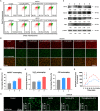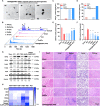Traditional Chinese medicine active ingredients-based selenium nanoparticles regulate antioxidant selenoproteins for spinal cord injury treatment
- PMID: 35701758
- PMCID: PMC9195429
- DOI: 10.1186/s12951-022-01490-x
Traditional Chinese medicine active ingredients-based selenium nanoparticles regulate antioxidant selenoproteins for spinal cord injury treatment
Abstract
Background: As Traditional Chinese Medicine (TCM) drugs, Huangqi and Danshen are always applied in combination for spinal cord injury (SCI) treatment based on the compatibility theory of TCM. Astragalus Polysaccharidesis (APS) and Tanshinone IIA (TSIIA) are the main active ingredients of Huangqi and Danshen, and they both possess neuroprotective effects through antioxidant activities. However, low solubility and poor bioavailability have greatly limited their application. In recent years, selenium nanoparticles (SeNPs) have drawn enormous attention as potential delivery carrier for antioxidant drugs.
Results: In this study, TCM active ingredients-based SeNPs surface decorated with APS and loaded with TSIIA (TSIIA@SeNPs-APS) were successfully synthesized under the guidance of the compatibility theory of TCM. Such design improved the bioavailability of APS and TSIIA with the benefits of high stability, efficient delivery and highly therapeutic efficacy for SCI treatment illustrated by an improvement of the antioxidant protective effects of APS and TSIIA. The in vivo experiments indicated that TSIIA@SeNPs-APS displayed high efficiency of cellular uptake and long retention time in PC12 cells. Furthermore, TSIIA@SeNPs-APS had a satisfactory protective effect against oxidative stress-induced cytotoxicity in PC12 cells by inhibiting excessive reactive oxygen species (ROS) production, so as to alleviate mitochondrial dysfunction to reduce cell apoptosis and S phase cell cycle arrest, and finally promote cell survival. The in vivo experiments indicated that TSIIA@SeNPs-APS can protect spinal cord neurons of SCI rats by enhancing GSH-Px activity and decreasing MDA content, which was possibly via the metabolism of TSIIA@SeNPs-APS to SeCys2 and regulating antioxidant selenoproteins to resist oxidative stress-induced damage.
Conclusions: TSIIA@SeNPs-APS exhibited promising therapeutic effects in the anti-oxidation therapy of SCI, which paved the way for developing the synergistic effect of TCM active ingredients by nanotechnology to improve the efficacy as well as establishing novel treatments for oxidative stress-related diseases associated with Se metabolism and selenoproteins regulation.
Keywords: Antioxidant selenoproteins; Selenium nanoparticles; Spinal cord injury; Traditional Chinese Medicine active ingredients.
© 2022. The Author(s).
Conflict of interest statement
The authors declare that they have no competing financial or non-financial interests.
Figures






References
-
- Wang Y, Yang JH, Wan HT, He Y, Xu B, Ai CS, et al. Efficacy of Yangyin Yiqi Huoxue granule () in treatment of ischemic stroke patients with Qi-yin deficiency and blood stasis syndrome: a randomized, double-blind, multicenter, phase-2 clinical trial. Chin J Integr Med. 2021;27(11):811–818. doi: 10.1007/s11655-021-2857-0. - DOI - PubMed
-
- Zheng X, Huang B, Lai Z, Zhu Z, Zeng W, Xuhui LU, et al. Clinical observation of different doses of astragalus compound on patients with spinal cord injury with Qi deficiency and blood stasis. Journal of Wenzhou Medical University. 2017;47(11):828–831,835.
-
- Liu W, Zhou L, Feng L, Zhang D, Zhang C, Gao Y, et al. BuqiTongluo granule for ischemic stroke, stable angina pectoris, diabetic peripheral neuropathy with Qi deficiency and blood stasis syndrome: rationale and novel basket design. Front Pharmacol. 2021;12:764669. doi: 10.3389/fphar.2021.764669. - DOI - PMC - PubMed
MeSH terms
Substances
Grants and funding
- 82004385/National Natural Science Foundation of China
- 82174396/National Natural Science Foundation of China
- 2019A1515011916/Natural Science Foundation of Guangdong Province of China
- 2021A1515011455/Natural Science Foundation of Guangdong Province of China
- 202102010012/Science and Technology Program of Guangzhou
LinkOut - more resources
Full Text Sources
Medical
Research Materials
Miscellaneous

